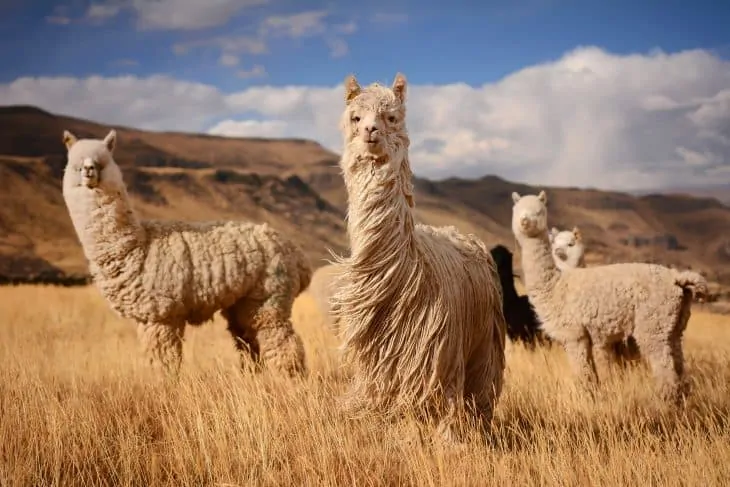
The llamas’ ancestors have been walking on earth for about 40 to 50 million years ago. And that is way ahead of humans since we only appeared between five million and seven million years ago. Today, slowly but surely, llamas are starting to gain popularity around the world as a pet and even for its meat. Here are some amazing llama facts to let you better understand this adorable species.
- ‘Lama Glama’ is the llama’s scientific name.
- A young or baby llama is called ‘Cria.’
- Its predators are coyotes, mountain lions, ocelots, and humans.
- Llamas are the camel’s “cousins.
- They are extremely social animals and love to live with herds.
- The lifespan of the llamas is around 15 to 25 years.
- The llama is a domesticated South American camelid.
- The extant members of camelid are llamas, Bactrian camels, dromedary camels, vicuñas, alpacas, and guanacos.
- Camelids are even-toed ungulates animals such as cattle, deer, antelope, and pigs.
- After the end of the last ice age around 10,000 to 12,000 years ago, camelids became extinct in North America.
- The llama’s wool is incredibly soft and without lanolin (wax from the sebaceous glands of wool-bearing animals).
- Llamas have a variety of colors including white, brown, grey, piebald, and black.
- A cria (baby llama) weighs between 25 to 30 lbs. Some cria can weigh up to 40 lbs.
- An adult llama weighs around 280 lbs up to 440 lbs.
- A llama’s average height ranges from 5 feet 6 inches to 5 feet 9 inches tall.
- Some llamas can grow up to 6 feet tall.
- They are smart and can identify between a friendly dog and a predatory coyote.
- Llamas mostly live in North & South America.
- Llamas eat approximately 2 to 4 percent of their body weight per day.
- They do not drink as much water compared to other animals.
Llama Facts Infographics
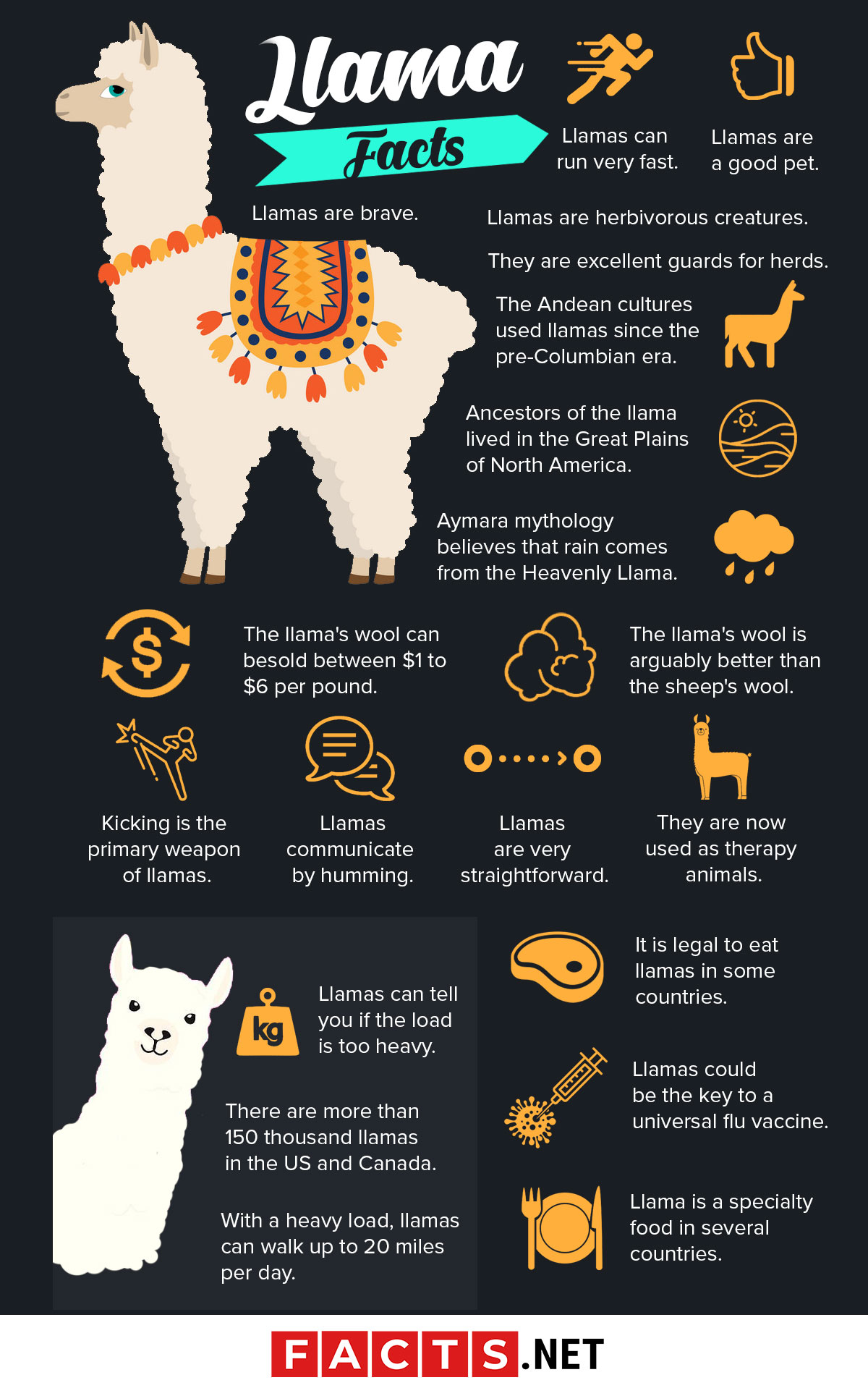
Llamas are herbivorous creatures.
Llamas are herbivorous creatures and grass is a big part of its diet. Moreover, they can survive by eating many different kinds of plants including forbs, tree foliage, native shrubs, tender shoots, and lichens.
The Andean cultures used llamas since the pre-Columbian era.
The Andean cultures or the indigenous peoples of the Andes mountains commonly used llamas’ meat and as pack animals (working animals used by humans as means of transportation) since the pre-Columbian era.
Ancestors of the llama lived in the Great Plains of North America.
Roughly 40 to 50 million years ago, the early ancestors of the llama lived in the Great Plains of North America. It eventually migrated to South America around 3 million years ago, when the two continents got connected or also known as the “Great American Interchange.”
Aymara mythology believes that rain comes from the Heavenly Llama.
According to the records of Aymara mythology (an indigenous nation in the Andes and Altiplano regions of South America), llamas are important animals. They believe that the “Heavenly Llama” drinks water from the ocean and provides the rain from its urine.
They are excellent guards for herds.
Llamas are also a proficient guard for herds. Moreover, they can blend well with other animals such as goats and sheep and able to protect them by chasing off some of the predators like coyotes.
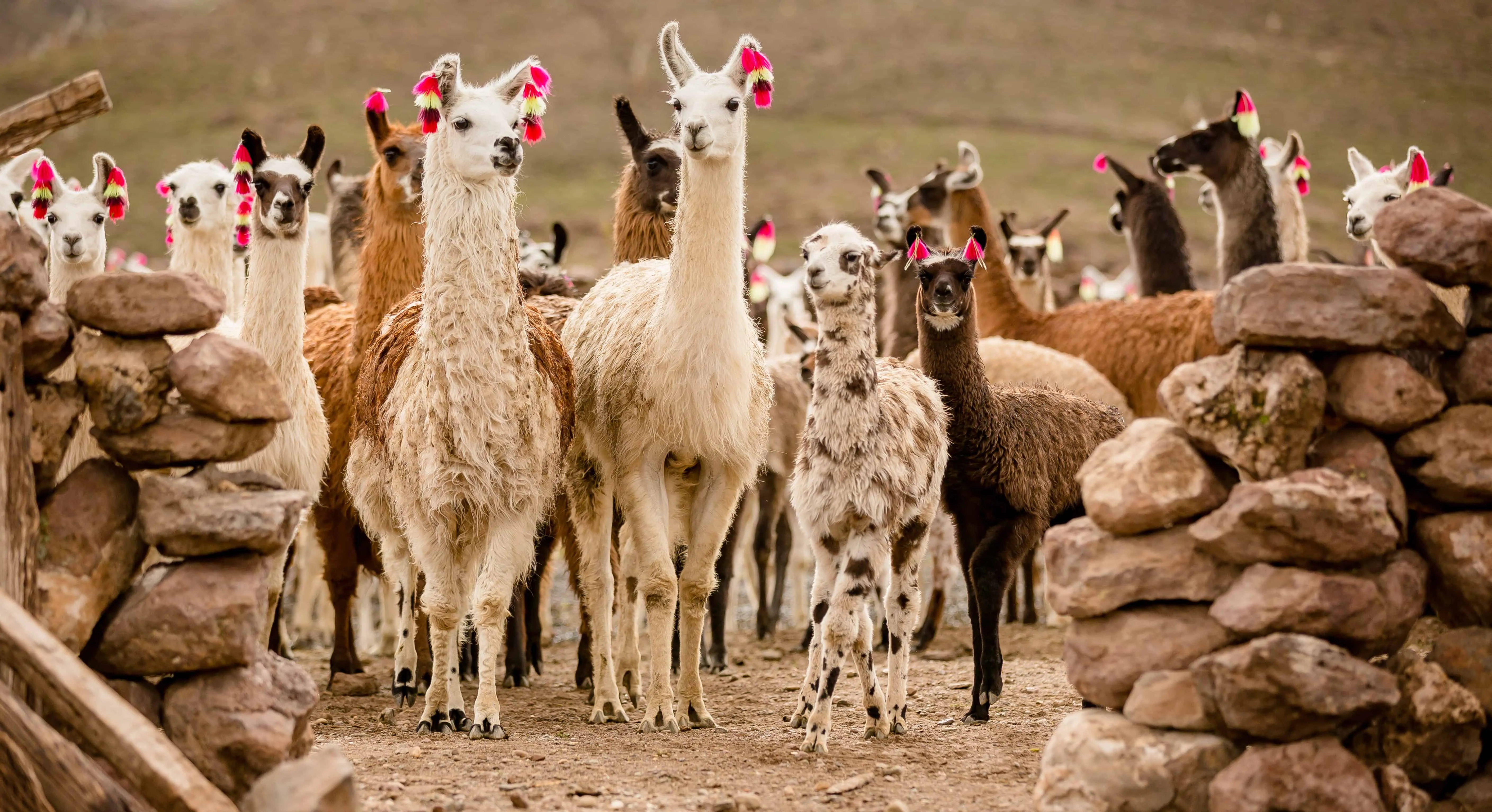
Llamas can run very fast.
An average dog, for instance, can run between 30 to 40 kilometers per hour while a llama can sprint of more than 60 kilometers per hour, giving them the ability to outrun some of its predators in the wild.
Kicking is the primary weapon of llamas.
Llamas react to its predators in different ways. Most often, they will start with a defensive stance or posture to alert others in the herd, then creating a special alarm cry. Soon, it may charge towards its enemy to prepare a strong kick.
Llamas are brave.
By nature, llamas are brave, fearless, and audacious against their predators. Moreover, even though they are herbivores, they can inflict serious injuries to coyotes and even kill them.
Llamas communicate by humming.
Primarily, llamas communicate by humming or by producing a wordless tone with the mouth closed to warn others of danger. Furthermore, they can understand each other’s body language such as a variety of ear, tail, and body postures.
Llamas are a good pet.
If you have the luxury of a spacious outdoor space, llamas can be a very rewarding pet, but always remember that keeping them alone is not a good idea for they are very social creatures. Furthermore, they are friendly, pleasant to be around, and loyal to their herd.
The llama's wool can be sold between $1 to $6 per pound.
Although wool as a word by itself can refer to sheep fiber, the llama fiber is also referred to as ‘llama fiber’ or ‘llama wool.’ The llama’s wool can be sold between $1 to $6 per pound and it will depend on its cleanliness, length, and volume of guard hair.
The llama's wool is arguably better than the sheep's wool.
The llama’s wool is also known to be hypoallergenic. Furthermore, its fibers are extremely warm, strong and durable, lanolin-free, water-resistant, versatile, and offers many natural colors depending on the llama’s variety.
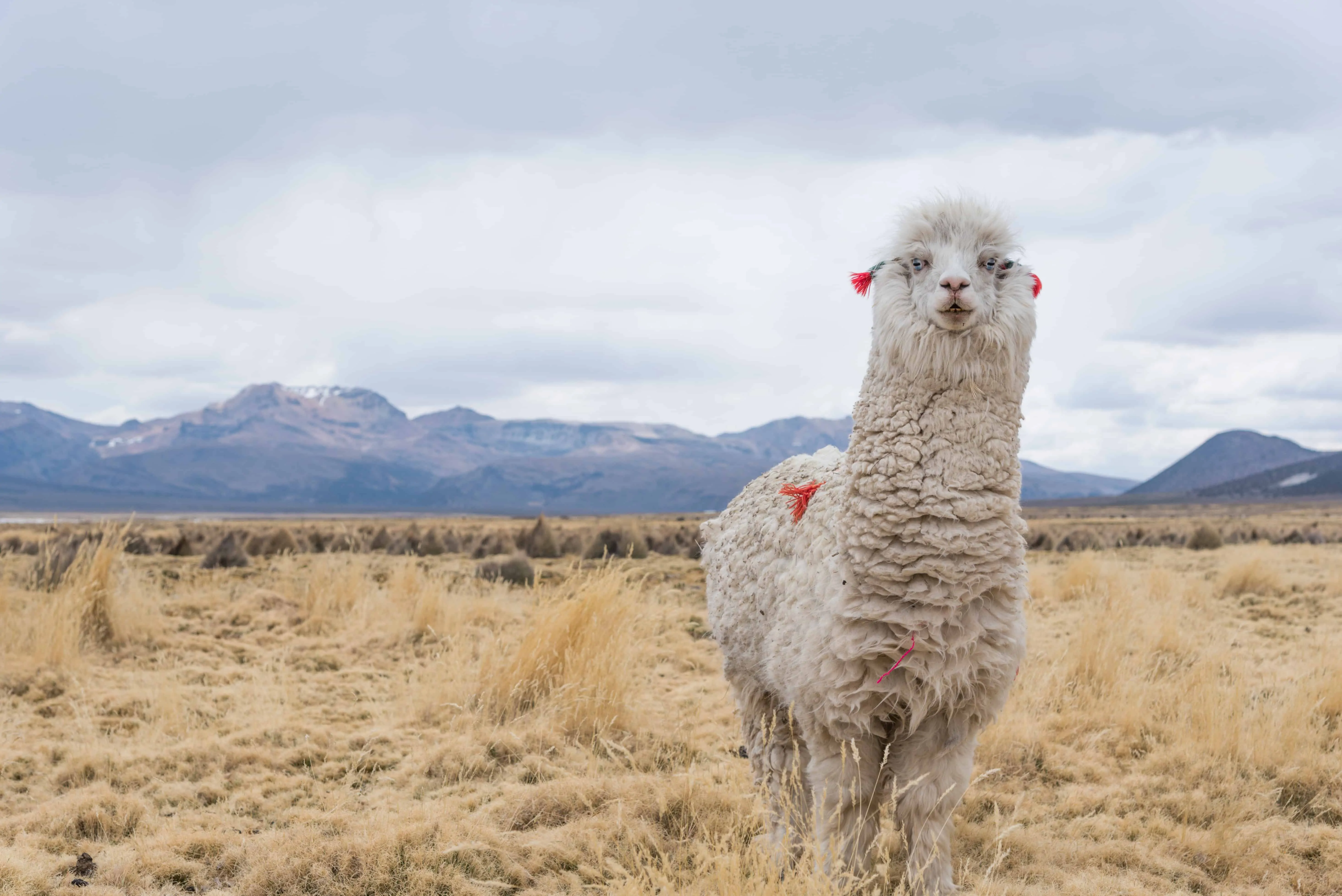
There are more than 150 thousand llamas in the US and Canada.
The United States first imported llamas during the late 1800s and placed them in several zoos as an exhibit. Fast forward today, according to the South Central Llama Association, there are more than 150,000 llamas in the United States and Canada.
With a heavy load, llamas can walk up to 20 miles per day.
According to National Geographic, llamas can walk and travel up to 20 miles per day with a load of over 70 pounds. Llamas will hike right behind its owner and they will match the pace of most people.
Llamas can tell you if the load is too heavy.
Are you worried that you might overload a llama as a pack animal or putting so much weight on it while walking? You shouldn’t be. Llamas are smart enough to tell you its limits. Hence, it will simply lie down or refuse to move when it’s overloaded.
Llamas are very straightforward.
Llamas are not shy to show what they feel from the inside. For instance, a llama can stick out its tongues to express irritation. Furthermore, they may also spit to establish a pecking order (hierarchical system of social organization) within its group, telling others to back off.
Llamas could be the key to a universal flu vaccine.
Scientists are now creating a universal flu vaccine to fight against every strain of the flu, and llamas are contributing a major role in the research. Moreover, the experts have produced a nasal spray coming from several llama antibodies – although it’s not yet proven, they agree that it has a huge potential.
They are now used as therapy animals.
Compared to some compaction dogs and some miniature animals, there’s something unique about llamas. Some llamas are trained as professional comforters and working as therapy animals in some nursing homes or the home for the aged, hospital, and schools.
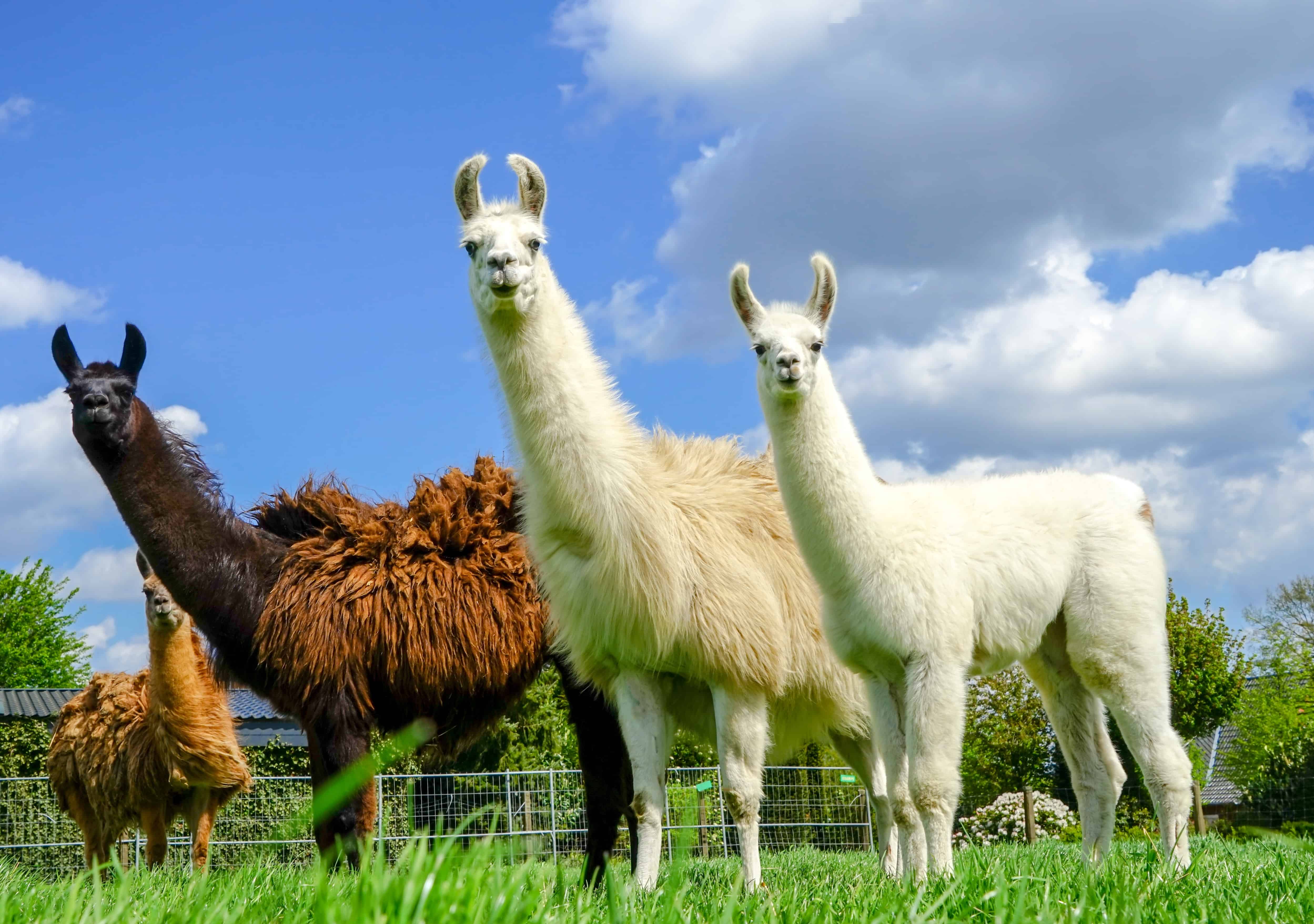
It is legal to eat llamas in some countries.
In the United Kingdom, for instance, they allow to llama meat as long as it was killed in the registered slaughterhouse and passed the required health inspections.
Llama is a specialty food in several countries.
Humans have been eating llamas for centuries already and it’s a specialty food in several countries like Bolivia, Chile, and Peru. Llama meat is relatively lean and its flavor is close lamb and beef.
Its meat is high in protein and low in calories.
A 100 grams serving of llama meat contains only 120 calories, 1 gram carbohydrate (3%), 3 grams of fat (23%), and a whopping 21 grams of protein (74%).
Llamas can walk on rocky terrains at high altitudes.
Llamas can handle or withstand harsh environments. Moreover, llamas are sure-footed or unlikely to stumble or slip, and they can navigate rocky terrains at high altitudes. Above all, they are intelligent and easy to train.
Llamas and alpacas have a very close resemblance.
At first look, llamas and alpacas (a species of South American camelid) may look very much the same but there are a couple of ways to differentiate them. First is their ears – llama ears are much longer with a “banana-shaped” while alpacas have short spear-shaped ears. Second, the alpacas have much finer wool than the llamas.
They don't bite humans.
Both llamas and alpacas generally don’t bite humans or their predators. Moreover, much like cattle, the llama’s is only at the bottom of its jaw and a dental pad on the top jaw.
The llama's stomach has three compartments.
Llamas have an efficient digestive system and its stomach has three compartments. They are the omasum, rumen, and abomasum. Much like cows, they also need to regurgitate and re-chew their food to digest it perfectly.
Female llamas mature much faster.
Llamas have an incredible reproductive cycle for a big animal. When female llamas release an egg during mating, chances are the egg is already fertilized on the first attempt. Like humans, both females and males have different sexual maturity rates. Furthermore, males become sexually matured when they reach 3 years old while females can be sexually matured as early as 1 year old.
Llamas are in a lying down position during mating.
Normally, large animals mate in a standing position but llamas sit or lie down while mating. They also mate longer than usual large animals. The mating of llamas lasts for about 20 to 45 minutes.
Llama gives birth in the morning around 8 up to noontime.
The pregnancy of a female llama lasts for around 330 to 350 days. The mother normally has one baby during pregnancy. Giving birth is usually problem-free and it only takes for about 30 minutes. They regularly give birth in the morning between 8 AM and noon.
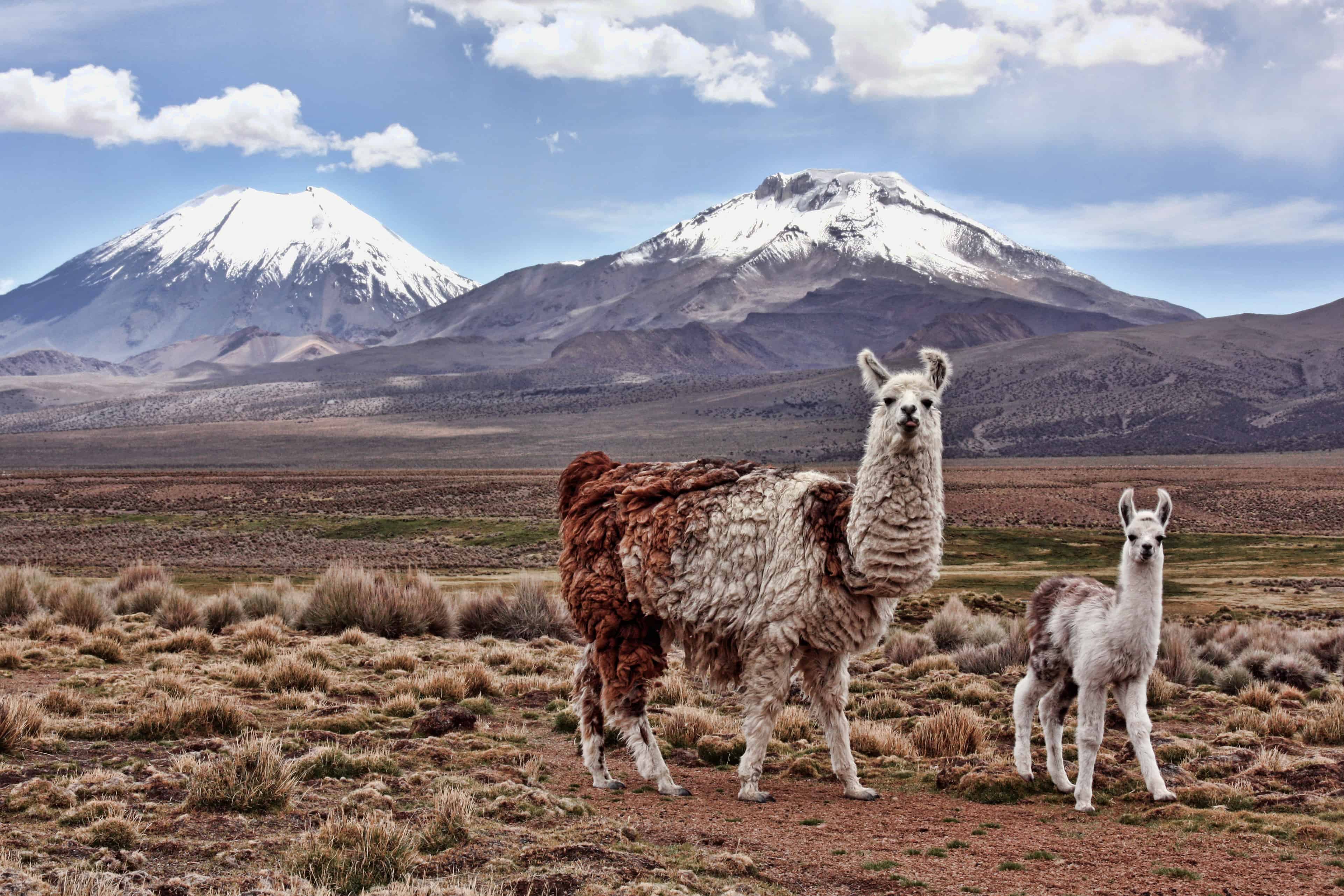
Its manure doesn't smell bad.
The llama’s poop or waste is nearly odorless. Llama farmers often call their manure as “llama beans,” and it’s an excellent eco-friendly fertilizer.
You can tame a llama in Minecraft.
The popular video game, Minecraft, has a llama. Llamas make a good pet in Minecraft, and to tame it, you will need either 5 hay bales or 10 wheat. Aside from llamas, you can also tame other animals in Minecraft such as horses, wolves, cats, donkeys, mules, parrots, and many more.
Was this page helpful?
Our commitment to delivering trustworthy and engaging content is at the heart of what we do. Each fact on our site is contributed by real users like you, bringing a wealth of diverse insights and information. To ensure the highest standards of accuracy and reliability, our dedicated editors meticulously review each submission. This process guarantees that the facts we share are not only fascinating but also credible. Trust in our commitment to quality and authenticity as you explore and learn with us.
